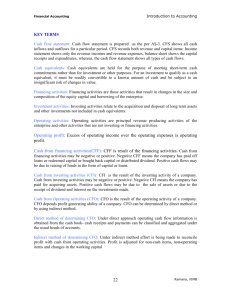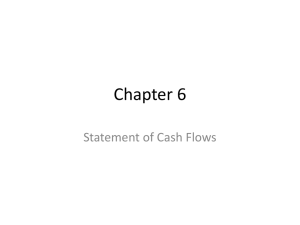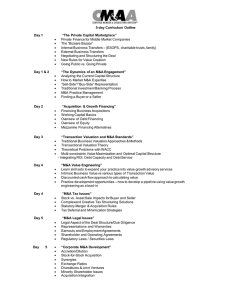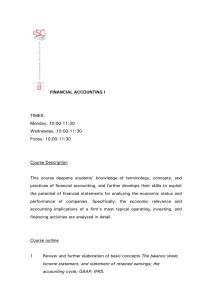Document 13616766
advertisement
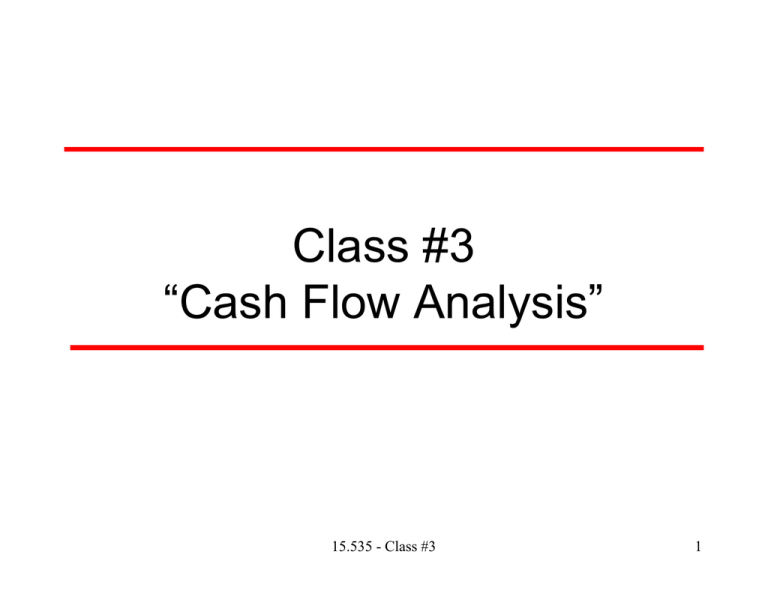
Class #3 “Cash Flow Analysis” 15.535 - Class #3 1 Quickie Announcements • In class on Thursday: Submit form with names of team members and your 3 company choices for project. • Matching team members. 15.535 - Class #3 2 Cash Flow Statement • Cash flow statement – Undo the current period accrual adjustments affecting • Operating, Investing, and Financing activities • Operating activities (income statement) • Changes in receivables and inventories – Real changes and potential fraud/manipulation • Changes in accounts payable and taxes payable • Depreciation 15.535 - Class #3 3 Cash Flows over the Firm’s Life Cycle: Implications for CF Projections Sales Net Income CFO Investing CF 15.535 - Class #3 Financing CF 4 Indirect Cash Flow Statement: Example • Indirect method: Walmart Stores, FY ending January 31, 2001 (‘000 dollars) Net income $6,295 Adjustments Depreciation and amortization Increase in Accounts Receivable 2,868 (422) Increase in Inventories (1,795) Increase in Accounts Payable 2,061 Increase in Accrued Liabilities 11 Deferred income taxes 342 Other 244 Cash flow from operating activities $9,604 15.535 - Class #3 5 Cash Flow Analysis - Walmart CFO = NI – WC Accruals + Deprec = NI – ['NonCash CA - 'CL) + Deprec = NI – ['AR + 'Inv - 'AP - 'AccLiab] + Dep = 6,295 – [422+1,795-2,061-11] + 342 + 244 + 2,868 = 6,295 – 422 - 1,795 + 2,061+ 11 + 342 + 244 + 2,868 = 9,604 15.535 - Class #3 6 Cash Flow Statements: Look for Creativity in Classifying Cash Flows • Classification of pre-opening costs by 50-Off Stores (a retailer) – Pre-opening costs of $7.7 million as investing activity – Operating cash flow in millions • Reported • Reclassifying pre-opening costs • Adjusted operating cash flow $10.3 (7.7) $2.6 • The next year, 50-Off Stores changed the classification to operating activity • Comparison: The Gap, Inc. Annual Report – Costs associated with the opening or remodeling of stores, such as preopening rent and payroll, are expensed as incurred. The net book value of fixtures and leasehold improvements for stores scheduled to be closed or expanded within the next fiscal year is charged against current earnings. 15.535 - Class #3 7 Cash Flow Analysis: Trend Analysis • Red flags: Growing discrepancy between net income and cash flows – Premature recognition of revenues • At a later date, A/R written off – IBM in early 1990s: Over-booked revenues from leases and shipments to distributors – Bausch and Lomb » New sales strategy in 1993: Instead of direct shipments to high-volume customers, business through distributors » Shipments to distributors included in revenues » $25 million revenues booked in the final weeks » B&L collected only 15% of the cash that distributors were scheduled to pay 15.535 - Class #3 8 Cash Flow Analysis: Trend Analysis EBX & CFO( $ millions) Lucent: CFO vs Earnings Before Extraordinary Items 5 0 1997 1998 1999 2000 2001 2002 CFO -5 EBX -10 -15 Year 15.535 - Class #3 9 Cash Flow Analysis • Red flags: Growing discrepancy between net income and cash flows • Undervaluation of liabilities • Reduced accrual for warranty expense – Overcapitalization • Asset write downs in later periods, no cash flow effect 15.535 - Class #3 10 Cash Flow Analysis – Amazon.com • Operating Section – Consider year ended December 31, 2002 • GAAP NI = ($149M) • Pro forma net income = ($66M) • Cash flow from operations = $174M – Question: What are main reasons for difference? • Why would Amazon focus on “Pro forma” numbers in its press releases? 15.535 - Class #3 11 Cash Flow Analysis • Investing activity – Management’s expectations • Increased investments if high growth is forecasted – Effect of the nature of business • Capital intensive – High investment in PP&E • Distribution/retailing – Leased outlets » Capital leases or operating leases 15.535 - Class #3 12 Cash Flow Analysis: Amazon.com • Investing activity – What does cash largest inflow come from? • Does this provide useful information about “operational” investments? – Compare 1999 to 2002 for Sales vs Purchases of marketable securities: • What does this tell us about “cash-burn”? 15.535 - Class #3 13 Cash Flow Analysis • Financing activity – Effect of the nature of business • Who finances with debt? – Growth options versus assets in place • Debt capacity of assets – Tangible assets, Steady cash flow generation – Investment not unique to the firm – Tax advantage of debt – Related to current operating performance • Growth associated with investing and financing 15.535 - Class #3 14 Cash Flow Analysis: Amazon.com • Financing activity – Proceeds from exercise of stock options … key thing to examine. Is this a “good thing”? – What type of firm is Amazon? • Growth options versus assets in place? • What type of financing would you expect? – Lets’ examine financing in past 5 years: • Look at 1999 “Proceeds from long-term debt” • What type of debt did Amazon issue? • Is this debt financing? 15.535 - Class #3 15 Cash Flows: Definitions • Back to course objective: Valuation and Analysis … For DCF Valuation, we want FCF! – Use Operating, Investing and Financing sections – Other Definitions of Cash Flow? (handout) • General Strategy for Valuation – Take current financial statements (Income Statement, Balance Sheet and Statement of Cash Flows) and project into the future • Key Issue: What are sustainable trends and what things are transitory? • How much reinvestment is required now (or in the future) to maintain and grow the business? 15.535 - Class #3 16 Cash Flows: Levered versus Unlevered FCF • FCF to a levered firm (ie the FCF to the equityholders of a firm with debt) is simple to calculate: – FCF = CFO + CFI • (CFO is “usually” >0, CFI is “usually” < 0) • What about enterprise valuation? • Must determine FCF to levered firm (ie create an all equity firm): – FCF = CFO + after-tax interest CF + CFI • Waste Management example 15.535 - Class #3 17 Cash Flow Analysis • Performance assessment: What is the benchmark? – Stage in a firm’s (product) life cycle: Young, growing versus mature firm – Industry: • Capital intensive versus labor intensive • Length of operating cycle • Assets in place versus growth options – Peer firm comparison 15.535 - Class #3 18 Cash Flow Analysis • Technology, growth firms like Microsoft – Software, growth options firm: Not much depreciation – Financing activity: primarily related to equity 15.535 - Class #3 19 Cash Flow Analysis • Airlines – Cash flow from operations is large compared to Net Income, even in loss years – Large depreciation and large investing amounts – Debt financing 15.535 - Class #3 20 Cash Flow Analysis • Retailers: – Walmart: Large wedge between CFO and Net income: Why? – Compare to Abercrombie and Fitch “ANF” 2000 1999 1998 Net Income $158M $149M $102M CFO $152M $153M $169M 15.535 - Class #3 21 Next Class: Using Accounting Earnings for Valuation • • • • Reminder about projects team names and company picks due next class Additional reading for today’s class: Look at examples in “Section D” of course packet (Income versus cash flows),Netscape (page 72), Walmart (page 73), Merck (page 75), American Airlines (page 76). Reading for next class: Handout about accounting valuation Assignment #1 will be distributed on Thursday. 15.535 - Class #3 22

